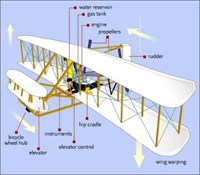- Lesson Plan (10)
- Teacher Reference Materials (1)
- Wright Brothers National Memorial (5)
- Dayton Aviation Heritage National Historical Park (3)
- Acadia National Park (1)
- Castillo de San Marcos National Monument (1)
- Chattahoochee River National Recreation Area (1)
- Fort Matanzas National Monument (1)
- Gateway National Recreation Area (1)
- Glacier National Park (1)
- Haleakalā National Park (1)
- Show More ...
- Social Studies (4)
- Literacy and Language Arts (3)
- Math (3)
- Science (3)
Showing 11 results for flyfishing ...
Pythagoras’ Kite
- Type: Lesson Plan
- Grade Levels: Middle School: Sixth Grade through Eighth Grade
Chattahoochee's Cold Water Fisheries
- Type: Lesson Plan
- Grade Levels: Middle School: Sixth Grade through Eighth Grade

Trout streams are particularly susceptible to thermal pollution, because they need to maintain cold temperatures year round. Trout streams are either well shaded or receive cold groundwater inputs. Artificial tailwater fisheries may be created at the outflow from large dams, where the size of the reservoir creates a steep temperature difference, with colder water stored at the bottom of the reservoir near the outlet. The Chattahoochee River below Buford Dam is an example of a tailwater fishery.
The First Four Flights--Math Up!
- Type: Lesson Plan
- Grade Levels: Upper Elementary: Third Grade through Fifth Grade

This lesson plan will allow students to understand the path that led to the Wrights' success on December 17, 1903 by relating the stories of their interest in flying from youth, the growing interest in flight in the late 1890s and the flight experiments that led to their first flights in 1903. The story of their dream to fly will be used as a backdrop for students to solve relevant mathematical problems and connect with Wright Brothers National Memorial.
- Type: Lesson Plan
- Grade Levels: Middle School: Sixth Grade through Eighth Grade
Commercial Travel: Then and Now
- Type: Teacher Reference Materials
- Grade Levels: Middle School: Sixth Grade through Eighth Grade
- Type: Lesson Plan
- Grade Levels: Upper Elementary: Third Grade through Fifth Grade

What were Wilbur and Orville like when they were in grade school? What did they do for fun? Why did they decide to fly? Explore all of these questions with your students in this in-classroom lesson plan designed to introduce students to who Wilbur and Orville Wright were. Students will research the brothers and construct a timeline of important events in their lives. Subject(s): Social Studies. Grade(s): 3rd-5th.
Canada Goose Migration
- Type: Lesson Plan
- Grade Levels: Upper Elementary: Third Grade through Fifth Grade

Many bird populations migrate, and the most common pattern involves flying north in the spring to breed in the temperate or Arctic summer, then returning in the fall to wintering grounds in warmer regions to the south. The longer days of the northern summer provide greater opportunities for breeding birds to feed their young. Many northern-breeding ducks, geese, and swans also are migrants, but need only to move from their northern breeding grounds far enough south to escape frozen waters.
- Type: Lesson Plan
- Grade Levels: Lower Elementary: Pre-Kindergarten through Second Grade

Native species are those that reached the islands without the help of people. Many of our native plants and animals occur nowhere else in the world! In this activity, students learn how the different characters (species) in the story could reach the isolated Hawaiian Islands. The class is divided into the different ways that species arrived (4 groups): fly, swim, ride on the wind, and waves. As the story is read, students try to figure out how each new plant or animal reached the island.






